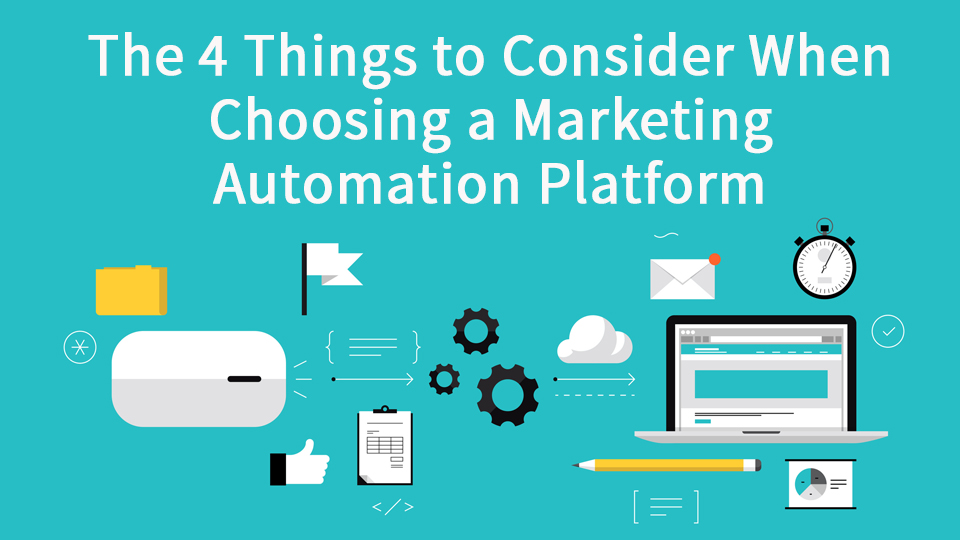Beginning to leverage marketing automation can be an intimidating prospect and vendor selection plays a big part in that. While there are dozens of platforms, this post will focus on what I would argue are the four marquee B2B marketing automation tools. They are:
There are of course many others (Act-On notably just missed making the cut); some are very focused on certain industries, while others, like SimplyCast, have more international appeal. There are also a host of great tools like MailChimp, that compete indirectly with marketing automation vendors.
For most B2B organizations, the decision on what marketing automation platform to choose will come down to one of the four options presented above. Which one is best depends on the organization, what other software they use, the type of customer they are pursuing, their budget and staff. If you aren’t sure if you should be using marketing automation, check out this post. So, without further ado, here are four things to consider when choosing a marketing automation platform:
Integrations with Other Products
Be sure to choose a vendor that provides a fully supported integration with your CRM and that it has near real-time syncing. Any vendor that syncs only a few times a day with your CRM should be excluded from the consideration pool. All four products outlined in this post integrate with Salesforce and Microsoft Dynamics off-the-shelf and all but Eloqua also integrate with SugarCRM and NetSuite.
Hubspot has its own mini-CRM, but also provides a wide variety of integrations with various marketing, sales and ecommerce tools (full list here). Like Hubspot, Marketo is an independent entity, so they also integrate with a wide variety of CRMs, as well as services like WordPress, Magento and Hootsuite.
Pardot is now owned by Salesforce, meaning that naturally they have a very strong integration with that CRM and you can expect it to get even better. Of the major platforms, Eloqua seemingly has the smallest number of integrations, or at least the poorest documentation for them. Need to know more about integrations? Check out this post.
Additionally, consider if there is a history of your industry using a particular product. As an example, I work with several SaaS startups that use Hubspot because of its jumpstart program for companies in incubators. In a related fashion, many Mortgage Brokers and Insurance Brokers are heavy users of the Salesforce CRM, in part because there are plugins specifically designed for their needs.
Features Set vs Ease of Use
Hubspot has historically focused on the SMB market and while the tool has become increasingly complex over time, they provide excellent training for new users and pros alike. If ease-of-use is a primary consideration and you do not have an employee who will be a full-time user of the platform, they may be the best option for you. Pardot also has some easy-to-use features, but their training and on-boarding is arguably not as robust as Hubspot’s.
Finally Marketo and Eloqua are two of the most powerful marketing automation tools on the market. They are designed to be adopted and implemented by large organizations that can afford not only outside expertise, but also to dedicate staff to becoming full-time power users. These are complex, feature rich tools, but are more difficult and time-consuming to use.
Scalability
All four of the major marketing automation platforms can scale far beyond the needs of the average SMB. Generally though, marketing automation pricing is based heavily on the number of contacts in your platform or CRM. This means that costs can increase rapidly in the wake of successful lead generation campaigns and company growth.
In theory, all four platforms could service a multinational or Fortune 2000 company, but at that scale, Eloqua and Marketo are likely best equipped for the job. Pardot and Hubspot have made a lot of headway, but global organizations have security, multilingual, legal and capacity considerations that really should be left to a platform (and staff) that is specialized to cater to them.
Cost
Cost isn’t as simple as just referring to the list price on a website. While most vendors require annual upfront payments and have configuration or training fees, their cost structures vary. Capterra does a good job at comparing options in this post.
Marketo and Eloqua are often considered to be best suited for large scale enterprises and their features, complexity and price reflect that. Pardot tends to be less costly and Hubspot, who historically has serviced the SMB market, tends to be the friendliest on the wallet, especially if one factors in their free CRM. However each has their own pricing idiosyncrasies that may impact the total cost to your organization. Here are the pricing pages for each: Marketo, Eloqua, Pardot and Hubspot.
A savvy buyer will consider more than just the cost of the software license and set-up fees. There is also staff training, costs for using an outside company to do your implementation, maintenance and migration costs and the hidden costs of implementing (or not implementing) add on services.
So which to choose?
There is no “right” choice or “best” marketing automation platform. Organizations have unique needs and while Hubspot, Pardot, Eloqua and Marketo are market leaders, there still may be another option better suited for your company. Need help choosing? Contact me and tell me a bit more about your organization, customers and goals.



